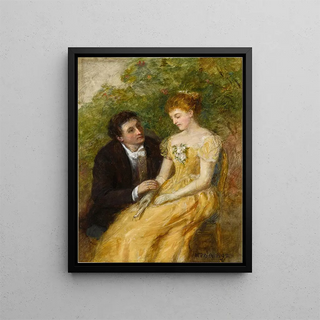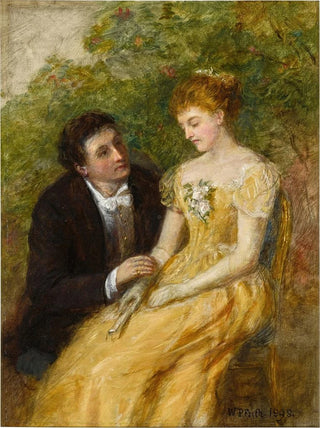Art print | An étude for In the Veranda, a Critical Moment - William Powell Frith Source: Reproduction | Une étude pour Dans la véranda, un moment critique - William Powell Frith


View from behind

Frame (optional)
In the world of art, some works stand out for their ability to capture moments of life with such intensity that they seem to transcend time. "An étude for In the Veranda, a Critical Moment" by William Powell Frith is one of these creations. This artwork, which depicts a snapshot of Victorian daily life, immerses us in an atmosphere rich in emotions and stories. Frith, a master of narrative painting, manages to evoke a multitude of feelings through the simple representation of a group of characters gathered in a living space. The scene, both intimate and universal, invites the viewer to reflect on human relationships and social dynamics of the era.
Style and uniqueness of the work
Frith's style is characterized by meticulous realism and particular attention to detail. In this étude, every element, from furniture to the clothing of the protagonists, is carefully rendered, demonstrating keen observation of its environment. Light plays a crucial role in this artwork, creating shadows and reflections that add depth to the composition. The artist uses a palette of warm colors that evoke a welcoming atmosphere, while also revealing a certain melancholy. The expressions of the characters, though subtle, are loaded with meaning, revealing personal stories and complex interactions. Frith succeeds in capturing not only the physical appearance of his subjects but also their emotional essence, making each gaze and gesture meaningful.
The artist and his influence
William Powell Frith is often regarded as one of the most important painters of the 19th century in England. His ability to tell stories through his works has left a lasting mark on the art world. Frith was able to incorporate elements of everyday life into his paintings, challenging the conventions of his time, which favored historical or mythological themes. His influence extends beyond his era, inspiring many contemporary artists who seek to explore narratives of modern life. By highlighting scenes of daily life, he paved the way for a new genre of art that continues to evolve. His artistic approach is part of a desire to represent

Matte finish

View from behind

Frame (optional)
In the world of art, some works stand out for their ability to capture moments of life with such intensity that they seem to transcend time. "An étude for In the Veranda, a Critical Moment" by William Powell Frith is one of these creations. This artwork, which depicts a snapshot of Victorian daily life, immerses us in an atmosphere rich in emotions and stories. Frith, a master of narrative painting, manages to evoke a multitude of feelings through the simple representation of a group of characters gathered in a living space. The scene, both intimate and universal, invites the viewer to reflect on human relationships and social dynamics of the era.
Style and uniqueness of the work
Frith's style is characterized by meticulous realism and particular attention to detail. In this étude, every element, from furniture to the clothing of the protagonists, is carefully rendered, demonstrating keen observation of its environment. Light plays a crucial role in this artwork, creating shadows and reflections that add depth to the composition. The artist uses a palette of warm colors that evoke a welcoming atmosphere, while also revealing a certain melancholy. The expressions of the characters, though subtle, are loaded with meaning, revealing personal stories and complex interactions. Frith succeeds in capturing not only the physical appearance of his subjects but also their emotional essence, making each gaze and gesture meaningful.
The artist and his influence
William Powell Frith is often regarded as one of the most important painters of the 19th century in England. His ability to tell stories through his works has left a lasting mark on the art world. Frith was able to incorporate elements of everyday life into his paintings, challenging the conventions of his time, which favored historical or mythological themes. His influence extends beyond his era, inspiring many contemporary artists who seek to explore narratives of modern life. By highlighting scenes of daily life, he paved the way for a new genre of art that continues to evolve. His artistic approach is part of a desire to represent






